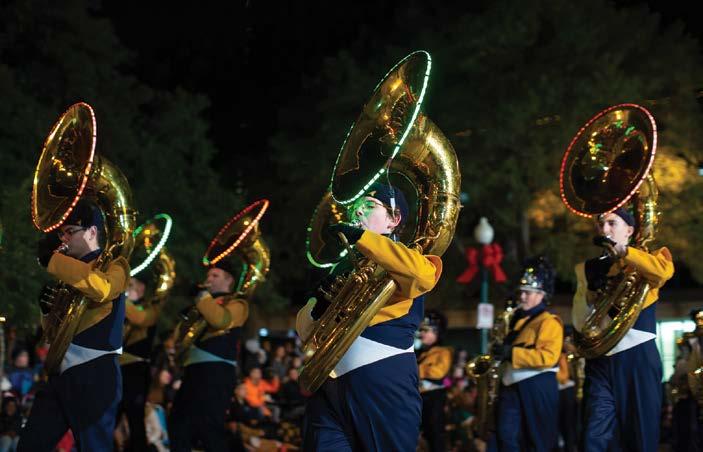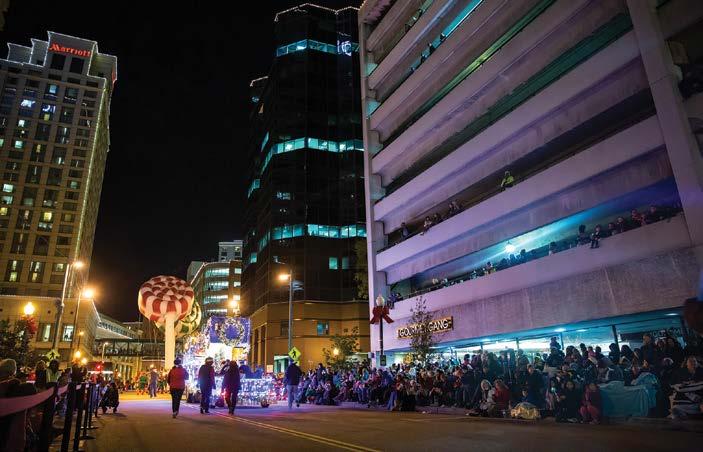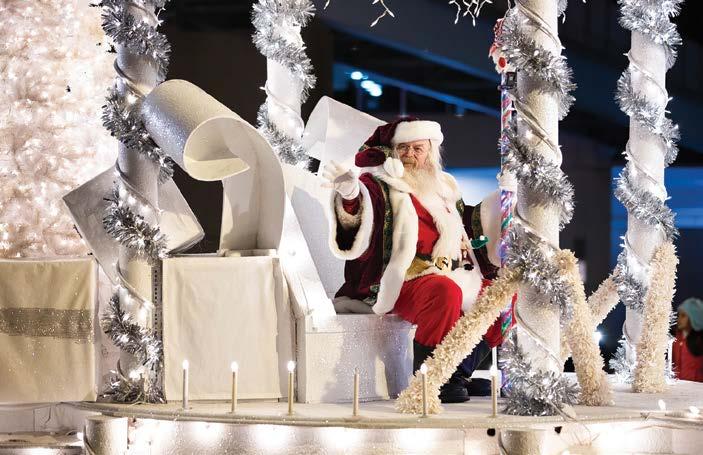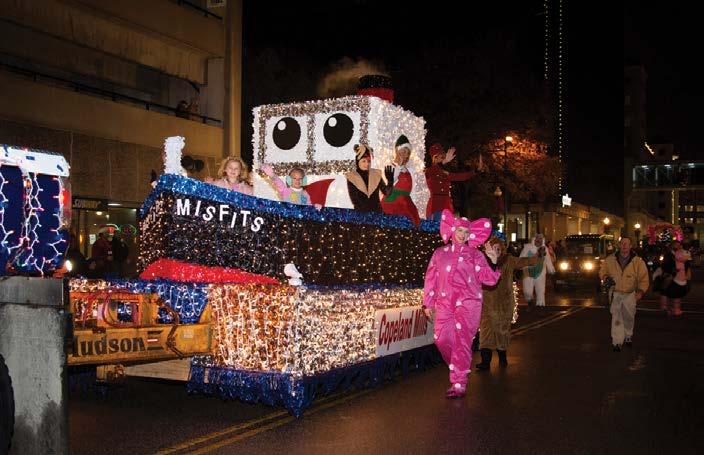
18 minute read
Holiday Magic
Photos courtesy of Downtown Norfolk Council
On November 23, 1985—the Saturday before Thanksgiving—two holiday traditions began in Norfolk: The outlines of the largest buildings in the city’s downtown skyline were illuminated with white lights, and a night-time parade was held to entice people downtown.
Advertisement
Cathy Coleman, who served as president and CEO of the Downtown Norfolk Council from 1983 to 2013, says she got the idea while attending a conference in Fort Worth, Texas. Cathy Coleman: “It was right around this time of the year, and everyone was talking about, ‘What are you going to do for the holidays in your respective downtown?’ Somebody at my table actually was from Fort Worth. He said, ‘We light the outline of all of our buildings with lights.’ I had never heard of such a thing. He ended up giving me a magazine that showed their skyline just being absolutely beautiful with all the lights that outlined the tall buildings. At that point in time, in 1985, Waterside had been there for two years, and they were doing really well in the summertime, but during the winter, the tourists weren’t there, and it wasn’t seen as a place to go. I had been with my team, trying to think: ‘How do we bring people downtown during the holidays? We’ve got to do something that’s extra special.’ So when I came home from the conference, I had this magazine with the pictures in it. And I went to my board, and I said: ‘You know, I think maybe we can start something like this.’ And they said: ‘Go for it!’”
Coleman recruited some architecture students to build a scale model of downtown Norfolk. The model was put into a three-foot long shadow box and illuminated with a black light to preview what the first “Grand Illumination” might look like. Cathy Coleman: “I took the box around to a number of different owners and said, ‘Would you be willing to pay to have lights put on your building?’ The first one who said yes was Bob Stanton with the World Trade Center. We ended up with, I think, five or six buildings that year. Once we had the commitment, then I had to go find somebody to hang the lights, and hanging lights off of tall buildings is not an easy thing!” Jimmy Schools, who worked as a special events manager for Goodman Segar Hogan, was tasked with hanging the lights on the Bank of America building (now ICON Norfolk). Jimmy Schools: “My boss had a meeting with Cathy Coleman after she came back from Dallas and had seen an amazing display of buildings being lit up and thought, ‘Why can’t we do that here?’ So she met with the building manager at the time and asked him if it was possible. He didn’t really know if it was, but when he came back to our building and met with us, he just said, ‘We need to light the building up.’ We didn’t know we had the choice of saying whether it was possible or not! But we had a ‘can do’ team. We rose to challenges like that. We put our heads together and came up with a way to use some stainless steel wire and conventional old lighting. It was a pretty massive system that we went with at the time. Once we figured it out for our building, then other buildings started calling, ‘OK, so how did you do it?’ So we had the opportunity to go around and meet with other buildings downtown. Every building was a little unique. It was a fun time to try to think of different systems that we could use to get that going. And we did it all with in-house labor.”
The idea for the parade came second. Cathy Coleman: “We needed to find a way to really celebrate the fact that we had this beautiful skyline. So I thought, ‘You know, everybody loves a parade. That’s a great way to bring kids downtown with their parents to see this wonderful backdrop.’ Channel 3 said they would televise the parade. We ended up with a lot of Girl Scout and Boy Scout troops. I went to the school board, and they jumped on board and said that all of the school bands in Norfolk had to participate in the parade. So we had lots of bands. And, of course, Santa Claus was the float in the parade, and the rest is history.”
Coleman says the Downtown Norfolk Council (DNC) was committed to improving the event every year. Cathy Coleman: “We ended up eventually putting a sound system in so people all over downtown were counting down, and the lights would come on. So that was a great participatory feeling. And the parade itself—we had judges, and people would win prizes for doing a great job with their float. So every year there was competition. It just got better and better as we learned more. We would get together after the parade and talk about what worked and what didn’t work and how we could improve it. So it was a constant reinvigorating—and, to a degree, reinventing—of what we were doing. To me, that was just really critical to making it continue. Every year there is a theme. That’s the other thing that I think has helped: It’s not the same every year. As the themes change, the floats change. People feel like they’re coming to something that is a great tradition, but it’s different than it was a year before.”
Noel Gramlich started working as parade volunteer in the 1990s. She was hired by the DNC in 2005 and has managed the parade ever since. She’s seen a lot of changes over the years— most driven by the growth of downtown. Noel Gramlich: “The parade route has route changed a couple of times. When I first started, it ended on Granby Street, right down around the Freemason area, but the crowds became so large that we needed to extend the route. So we ended up extending it across Brambleton, ending at the Harrison Opera House to give more space along the route for people to view it. Then when light rail started, we had to change the route again because we cannot take the units over the tracks or under the catenary wires. Now it starts and ends in Harbor Park, which makes it much easier for the participants.” One of Gramlich’s biggest tasks is recruiting more than 300 volunteers to work before, during and after the parade. George and Helen Cox have answered the call for more than 20 years. In addition to serving on the volunteer planning committee, they lead the line-up of parade units at Harbor Park. George Cox: “I spent 33 years with the Department of Defense and have almost circumnavigated the Earth. I’ve been to some interesting places at interesting times. Really, I think I’ve benefited by all the people that I’ve dealt with—language barriers, customs, all sorts of different things. But there’s nothing like putting that parade together.” Helen Cox: “He’s tearing up. He’s like a little boy at Christmas when he hears Noel say, ‘Let’s get started for this year’s parade.’ It’s something he enjoys.”
For the record: Helen is equally committed—so much so that she has postponed a planned hip surgery until after this year’s parade. Helen Cox: “It’s a lot of work, and the next day you might be suffering a little bit with your muscles, with all the walking and the cold, but it definitely is a rewarding feeling to see the people, the participants—their excitement being in the parade—and then the spectators and the cheers. It’s happiness, and we don’t have a lot of that sometimes. It’s a way for people to come out and embrace our community and enjoy the fact that they live in the area and have these opportunities.” Noel Gramlich: “I’ve built a lot of relationships with volunteers. The parade committee that we have now comes back year after year. A few people have moved, but the majority of them, when I send an email out asking if they’ll participate, they say yes right away.”
Mary Miller also worked as a volunteer for the parade in the 1990s before joining the DNC in 2004. She has the added distinction of succeeding Coleman as president and CEO in 2013. Her parade responsibilities range from leading the DNC staff, to securing sponsors for the event, to meeting with the city on logistics, including street closures to trash collection. Mary Miller: “We’re very fortunate that we have Noel, who’s been doing the event for a long time. So I’ve been able to step back from all of the details that I used to be involved in. Several years ago, we also started hiring a consultant to help with some aspects of the parade. Obviously, it’s a huge event that would consume the entire staff.

I mean, literally from Labor Day through to the parade, we would not have much capacity to work on other projects, and there was interest—certainly amongst the DNC board—that we’d be able to keep other projects moving forward at the same time we were working on the parade. The only way to be able to do that was for us to parcel out some elements of the event.”
One of the tasks that is outsourced is the lighting the buildings, but Jimmy Schools, who now works for Hertz Investment Group in the Dominion Tower, has stayed involved in a consulting role. Jimmy Schools: “Next couple of weeks, you’ll start seeing window companies and installers starting to come down and hit all the buildings. Usually, we’ll get it done the first of November, and then the window company will come and do another check a couple of days before to make sure every light’s working. We’re sticklers. We like to see every light lit. It’s gotten to the point now, we’ve done it so many years, each building has sort of learned on its own. That’s been the beauty of this going on so long—the legacy of it. We’ve all learned that now, and the owners of each building have also agreed to the benefit of doing this, so they’ve committed the funds that we all need for each building. So it goes well beyond just the people here. It’s all the owners of these buildings that are sometimes nationwide that are also committed. So it’s been a great program.”
Marathon Development Group owns 12 residential buildings downtown, including ICON Norfolk, the former Bank of America building. Raffaele Allen is Marathon’s chief operating officer. Raffaele Allen: “We have quite a few buildings up and down Granby Street. In 2013, we started with the Wainwright. Now, anytime we do a development in downtown, we make sure that the buildings have holiday lights incorporated into the crown of the building at the very top—and then obviously the drops. We work closely with DNC all the way up to the event with regard to ensuring that we have our lights lit at the appropriate time. We turn it into a big event for our residents, and we have a large holiday parade watch event.”
After more than three decades—and despite the different themes—individual parades have blurred into one another, but there are a few memories that stand out. Cathy Coleman: “The one thing that stands out to me—almost more than anything—is 1992. I remember that year very well. It was the year that the Marriott opened. They called me in the summertime and said they were going to work toward having lights on the building and use the beginning of ‘Holidays in the City’ as the time that they would have their official grand opening. So that year we changed the parade route. The long and short of it is: At the end of the parade, Santa Claus’ float was going to stop, the TV cameras were going to be on, and Santa was going to actually lower a scepter so the lights would come on the Marriott hotel for the first time. Getting that to be exactly at the right time—with the TV cameras rolling—that’s hard to even do on a newscast, let alone having a float that’s gone through a parade route. But we pulled it off! And not even 10 minutes later, the sky opened up. I mean, the parade was over, but at that point, the sky opened up, and it poured down rain. And that’s pretty much the only time it’s rained. I retired with a clean record. No rain on my parade!” Helen Cox: “My biggest memory is Booker T. Washington [High School]. They were in the middle of the parade that year. They hadn’t arrived, and I’m like, ‘They’re only a couple of blocks away. What is going on?’ But something was going on at Booker T. that day, and they had a hard time getting their buses out. When they got in the bus, the bus wouldn’t start. Finally, the band director told the kids: ‘We’re walking over there.’ They ran! They got to Waterside right when they should be stepping off. So they were already exhausted. I felt so sorry for them all. I hurt for them because they wanted to be in it, and they had really already sacrificed a lot to make it happen.” Mary Miller: “A couple of years ago, we were right on the edge of having to call whether or not we could carry our big balloons down the
parade route because the wind kept picking up. If you know downtown, when you hit the cross streets going up Granby—like once the balloons got to the intersection of Granby and City Hall—the wind gusts were just crazy. But we all did OK, and it was just so great to see all the volunteers and everybody just pitch in and help hold the balloons. So maybe there were eight people carrying a balloon, but you really needed 16 to be able to manage it. Everyone just pitched in together to continue those balloons down the route, which was just phenomenal.” Noel Gramlich: “I hate to even mention it because I might jinx us. The only time it ever rained was in 2019. The parade still went off, but it had rained, and then it stopped right at 7 o’clock when we stepped off, but, you know, some of the units canceled. Some of the bands that can’t march with their instruments out in the rain—some of the high school bands, some of the floats and all. But we still had a parade.”
While Norfolk’s skyline was illuminated in 2020 and 2021, the parade was canceled because of the COVID-19 pandemic. The call to revive the parade this year was just made in August. Noel Gramlich: “We didn’t think we were going to be able to have the parade this year, but we found out in early August that we could, so that’s when we started planning. Normally we would start in January/ February with the sponsors and all, but we’re making it happen. People are excited.” Mary Miller: “It takes time. It’s a lot of communication and proposals that you’re putting together for different people to get their interest in supporting the event. Typically, June/ July is when the announcement would be made that applications are open for the parade. Noel has done an amazing job. I think we have 67 units in this year’s parade, and considering we started all of this at the end of August—I mean, she just has a lot of connections and just really aggressively went after contacting units and getting people to participate.” Helen Cox: “Noel is one of the most organized people with whom I’ve ever worked. I mean, she is on top of things and outstanding. So much of the credit for the parade—I would say 98% of the credit for the parade— rests on her shoulders. She’s just a remarkable person.”

George Cox foresees a new challenge this year: A significant portion of the Harbor Park parking lot, which is used for the parade units to line up, is not available because of the casino construction project. George Cox: “We’ve lost at least a third—if not more—of the Harbor Park lots. This year is going to present challenges that we’re going to have to overcome to be successful and get everything moving the way we have in the past. But I’ll tell you what: Every challenge that we’ve had over the years, we have surpassed with our critical thinking and fixes, so I’m not worried at all this year. I know we will excel again with our brainstorming and our fixes.” Marathon Development Group, along with S.L. Nusbaum Realty Co., is this year’s presenting sponsor. Raffaele Allen: “We’re really excited to be able to assist. We know that this is the first year that it’s back since the pandemic, and we’re excited to see it back. It brings so many people to downtown Norfolk. It really kicks off the holiday season in spectacular fashion. Our residents each year have asked us when the parade is coming back, so we were thrilled for S.L. Nusbaum to notify all the residents that this year we’d be ushering back in the parade with the DNC and hosting our annual event. So we’re excited. is a great time of year to get everybody together.” Jimmy Schools: “You know, what we’ve been through as a country during the pandemic—I think it’s probably even more precious to us that there’s things like this that we can get back to. We lost it for a couple of years. Now it’s back. It’s great seeing people come out. We have a renewed appreciation for the little, simple things in life, like getting together for Christmas parades and things like lighting buildings. Maybe we didn’t have the appreciation that we should have.”
Downtown continues to change, but the legacy of the Grand Illumination

Parade has remained constant: Year after year, it attracts as many as 100,000 people to Norfolk to kick off the holidays. Mary Miller: “I think for downtown in general, it’s just a huge opportunity for visibility. When you have those kinds of crowds, it’s an image-builder for downtown. They have a great experience with the parade, and they see other things to do. They say, ‘Oh, there’s a restaurant I’d like to try out.’ Or ‘Oh, there’s a store I’d like to go to.’ Or someone’s new to the area, and they come and attend the parade, but then they see, ‘I can come back and go to WinterFest on the Wisconsin.’ Or ‘Oh, there’s an ice rink downtown.’ I mean, for us, it’s just building that opportunity to get them to come back. And obviously, the day of the event, our hope is they’re extending their stay there on the front end or the back end of the event in that they are going to our restaurants and enjoying more time in downtown.” Raffaele Allen: “I can’t emphasize it enough: Mary Miller and her team are incredible—all the things they do for downtown. They do so much, and the holiday parade is, to me, kind of like the cherry on top. It’s just such a special event. Mary Miller and her team do a phenomenal job.” While the parade began as a way to showcase downtown Norfolk, it has grown into a cherished holiday tradition. Everyone associated with the event says it’s all about the joy it brings to children and their families. Noel Gramlich: “It’s a cherished holiday tradition. I mean, for 36 years, it’s been happening. We have people that were children that are grown up, bringing their children to it. We hear that all the time. We have bands that come from all the cities around. We’ve had bands that have come from out of state before to participate. So I think it’s important. It’s a way to bring the community together. It’s a way to showcase Norfolk during the holidays.” Raffaele Allen: “I would say the most exciting part of it is just kind of seeing the excitement that everybody gets. It just ushers in a different attitude that time of year, where everyone is reminded how precious it is to spend time with friends and family and appreciate each other. It’s not just the retail side of it; it’s the excitement that it brings in and reminds everyone how special it is to be able to spend time with your close friends and family.” Mary Miller: “I think it’s just seeing the children, the smiling faces, the kids. I mean, they just love it. They’re so excited to see Santa. The look on their faces is just amazing. It’s so nice to see families where it’s been a tradition. The parents used to come to the parade with their parents, and now they’re bringing their children. That’s the best part of it. But there’s a lot of adults who love it too. But I just say seeing the excitement of the children is just absolutely phenomenal.” Cathy Coleman: “I remember the first year, standing in front of the TV cameras, and they were asking me, ‘What do you think the future is? You know, when you close your eyes and think ahead, how do you think people are going to view this event?’ And I said, ‘Well, what I’m hopeful of is that people will bring their children 20 years down the road. I hope that their children are bringing their kids. To me, that would be the great sign of success.’ Many times, I have had people say to me, ‘You know, the first time I ever went to the parade, I was 3 years old, and I was sitting on my daddy’s shoulders, and now I’m here with my grandchildren.’ So that’s a really nice feeling.”
The Downtown Norfolk Council will host the 36th Grand Illumination Parade at 7 p.m. on Saturday, Nov. 19. For more information, including a map of the parade route and nearby parking locations, visit: www. downtownnorfolk.org. The parade will be livestreamed on the Downtown Norfolk Council’s Facebook page.
Jim Roberts started his career as a features writer and editor at two daily newspapers. He now works full time in the world of corporate communications but continues to freelance as a writer and bagpiper. This is his first story for Boulevard.









